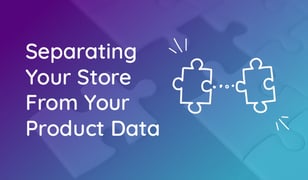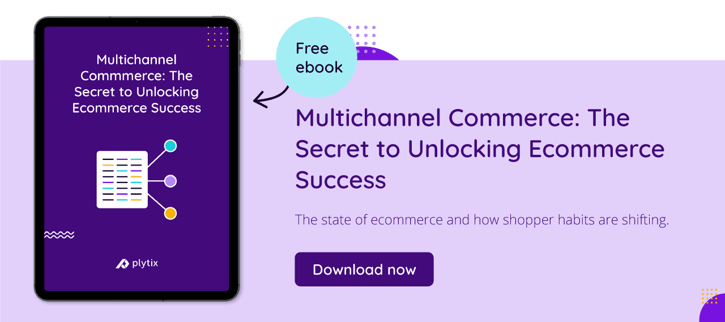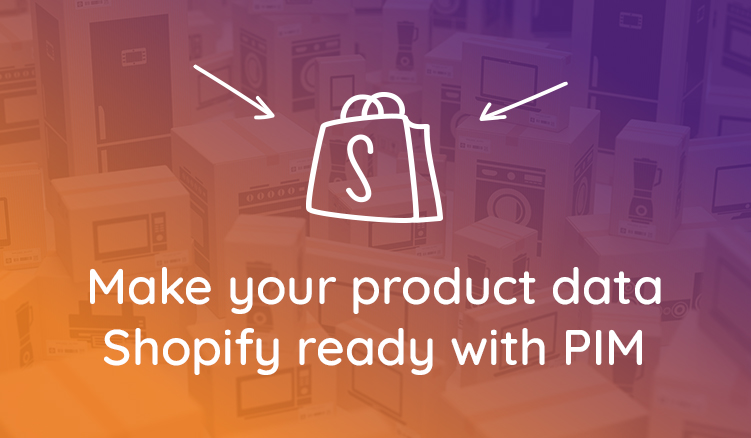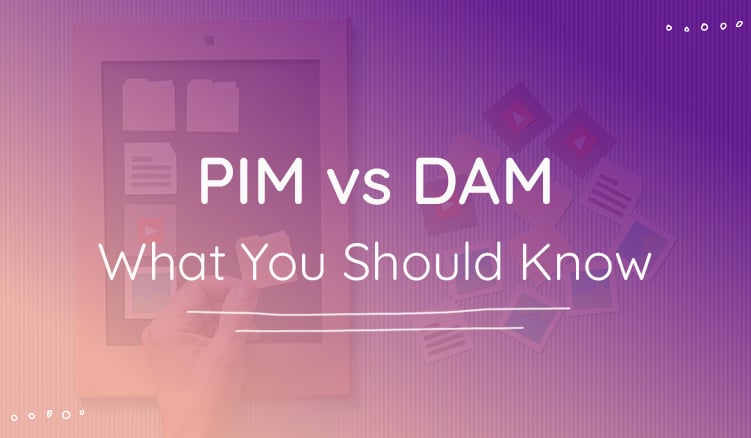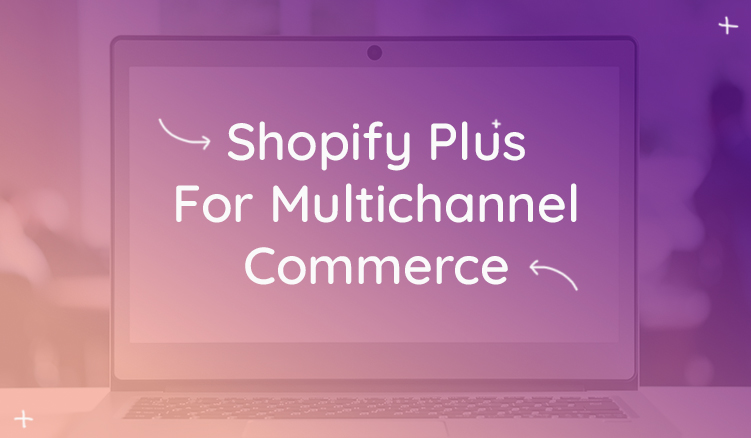Whether you’re the new kid on Shopify’s block or an experienced seller in the ecommerce sphere, there’s always room for improvement.
And it starts with your product information.
When you first began the process of creating a webshop, it made sense for you to manage your product data in your ecommerce platform. You hadn’t thought about how selling in one place would evolve into multichannel commerce—and to be frank—who knew this transition would come with such strict requirements?
Apart from the channel frustration, most ecommerce platforms, like Shopify, have additional product and marketing limitations that can stunt your growth. Which is why many brands decide to separate their store from their product information.
Here are three, for example. There is no completeness tracking. This makes filtering limited and taxonomy improvements difficult. Shopify’s data requirements are also unconventional, so any content will need to manually be tweaked before syndication. And lastly, it is difficult to associate a file with multiple products.
When you look at Shopify’s range of capabilities, it’s evident why it’s one of the top three leading ecommerce solutions and innovations in the world. With 1 million users and millions of more worldwide visits every month, it truly is a no-brainer. (So, tap yourself on the back—you’ve started your journey on the right foot.)
As we've seen, Shopify comes with a lot of perks. When it comes to managing product content at scale or selling on multiple channels, specialized Product Information Management software like Plytix PIM is necessary. Quality content is the backbone of ecommerce success, and managing it can be overwhelming. With the right content and product feed management tools, you can be more efficient in maximizing your store’s potential and making strategic decisions.
Before we dive into why you should separate your store from your data, you should first know what this actually means for your business. Essentially, you will keep using Shopify for your storefront but you will leverage a third-party system to manage any ecommerce content for marketing. Once centralized, all content can be distributed to your ecommerce platfrom, Shopify, and to any other channel.
1. Each sales channel has its requirements
Each sales channel has criteria of how they want content to appear—and managing each version of this data is not possible in your Shopify store. For example, Amazon prefers bullet point features and a 2000 character limit for descriptions. If you decide to use your existing content for every marketplace or channel, you will face refusals or poor-ranking listings. Why? Because the information in your Shopify store is 100% compliant to that particular platform. It will not flourish anywhere else, so you'll need an alternative solution.
Either way, you need to accept each channel’s requirements. But what it comes down to is how and where you’re going to store this product information. You can forever work in (chaotic) spreadsheets, or you can use a PIM for Shopify as your central source of truth.
Once you’ve created unique content for different channels, you will have complete control over the customer experience of each listing. This will help you maintain a consistent presence and stay in the good books of all these channel providers.
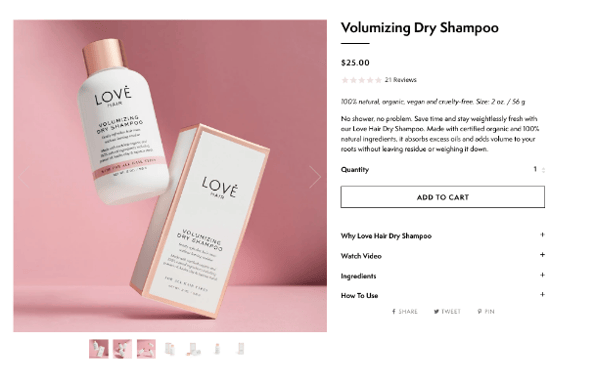
Example of a Shopify product listing - Love Hair
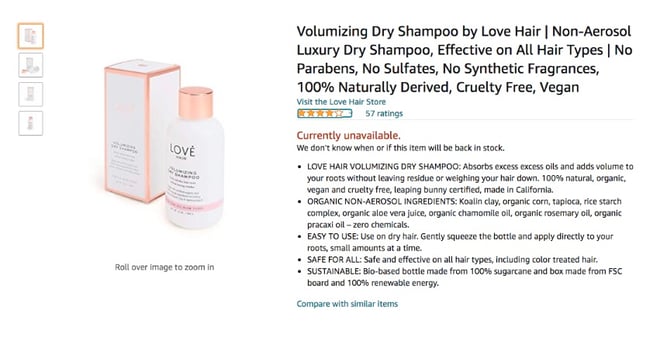
Example of an Amazon product listing - Love Hair
2. Product listing optimization will differ
With every channel, your optimization approach will need to change—optimizing for Googe Shopping won't necessarily help you on Amazon or Etsy. It’s easy to think that you can adapt your SEO or keyword strategy to any product content, but that's not the case.
A prime example of this is how Amazon’s A9 algorithm is specifically designed for product searches. It focuses on short-tail keywords, whereas Google prefers a series of long-tail keywords. Another one is how Google thrives on link juice to seek out trust signals and drive traffic. Amazon, however, works within itself and does not require any sort of links to weigh up your potential. They want to know what your conversion rate is and whether your listing is structured correctly.
It’s important to note that not every customer will arrive directly on a channel to begin their search, which is why a standard search engine approach is still vital. But start optimizing for humans as well—add value to the discovery process.
You simply cannot use the same SEO principles for every platform. So, do your research to see what each algorithm prioritizes in listings and treat each platform as its own strategy. *Always remember: whether you separate your data in a PIM or in spreadsheets, whatever content you create for different channel requirements will not be able to be stored in your Shopify store anyway. That content is specifically created for Shopify only. And you should keep it that way.
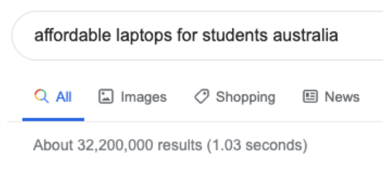
Example of a long-tail keyword for ecommerce
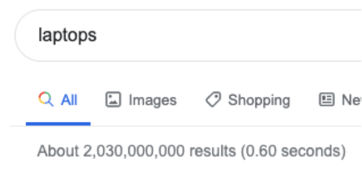
Example of a short-tail keyword for ecommerce
3. Duplicate content will affect your ranking
Wasting time on copying and pasting from spreadsheet to spreadsheet is the least of your worries—duplicate content is. Don’t copy content; it’s sabotaging your store’s ranking potential. Google can penalize you for duplicate content across multiple sales channels, meaning that your original content will not be prioritized. If content is duplicated from your main store, Shopify, and Google chooses to use an alternative platform as the main source, it will affect your web store’s performance. You might even find that your store gets ignored by crawlers.
While there are continuous algorithm updates in Google, one thing has always been clear, ever since the release of Panda: unique content ranks. By differentiating each product page and listing, you will prevent your pages from looking the same to bot crawlers, and you will increase your chances of occupying more of the top spots in search engine results pages (SERPs). Stay attentive and be as original with each channel as possible—rather endure this time-consuming process now to avoid the consequences in the future. With a PIM, you can store all your unique content in one place, and it’ll be accessible for anyone on and offline.
4. Cross department collaboration is not possible
Collaboration is vital. Product data is a team effort, and your teamwork shouldn’t be limited by the number of users you can add to a plan. In Shopify, you are limited with staff permissions according to the pricing plan you’re on. Even in the most advanced account, the limit is 15 users (and that’s going to cost you).
This is not ideal when you’re jumping between channels and content. Product information should be accessible to everyone, especially marketing and sales. The more eyes you have on your content, the more accurate your content will be.
A PIM is a collaborative tool that gives everyone access to just what they need. How convenient? (Plus, there's no risk of them breaking your Shopify store because they aren't working in it). No one will have to jump between spreadsheets or consolidate data into one master sheet. Every bit of data, from unique product identifiers to images, specifications, and more, can be stored in one place.
Make marketing easy for your team!
Just by separating your product data from your Shopify store, you’ll be able to spread your wings and grow your feeds. By managing your digital assets, product, and inventory in one place, Plytix, you can sell more with less effort. Now, you can easily see who your products are reaching and how they’re performing across channels. These insights will help you make real-time suggestions and decisions.
Get a demo to try any plan for free—with everything included!

